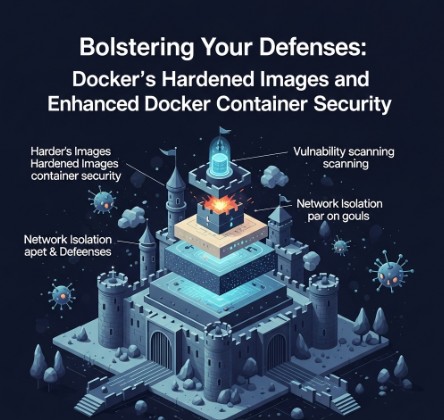In today’s dynamic landscape of cloud-native applications and microservices, containerization has emerged as a cornerstone technology. Docker, the industry leader in containerization, plays a pivotal role, simplifying application deployment and management. However, with the increasing adoption of Docker comes a growing concern: Docker container security. This article delves into Docker’s innovative solution to this challenge: Hardened Images. We will explore how these images enhance security, provide practical examples, and address frequently asked questions to help you elevate your Docker container security posture.
Table of Contents
- 1 Understanding the Need for Enhanced Docker Container Security
- 2 Introducing Docker Hardened Images: A Proactive Approach to Security
- 3 Implementing Hardened Images for Enhanced Docker Container Security
- 4 Beyond Hardened Images: Comprehensive Docker Container Security Strategies
- 5 Docker Container Security: Best Practices and Advanced Techniques
- 6 Frequently Asked Questions
- 7 Conclusion
Understanding the Need for Enhanced Docker Container Security
Containers, while offering numerous advantages, inherit vulnerabilities from their base images. A compromised base image can leave your entire application ecosystem exposed. Traditional security practices often fall short when dealing with the dynamic nature of containers and their ephemeral lifecycles. Vulnerabilities can range from outdated libraries with known exploits to misconfigurations that grant attackers unauthorized access. Neglecting Docker container security can lead to serious consequences, including data breaches, service disruptions, and reputational damage.
Introducing Docker Hardened Images: A Proactive Approach to Security
Docker Hardened Images represent a significant leap forward in Docker container security. These images are built with enhanced security features embedded directly into the base image, providing a more secure foundation for your applications. This proactive approach minimizes the attack surface and reduces the risk of vulnerabilities being introduced during the application development and deployment process.
Key Features of Hardened Images
- Minimized attack surface: Hardened images often include only essential packages and services, reducing the number of potential vulnerabilities.
- Security hardening: They incorporate security best practices like AppArmor profiles, SELinux configurations, and secure defaults to restrict access and prevent privilege escalation.
- Regular security updates: Docker actively maintains and updates these images, ensuring the latest security patches are applied.
- Enhanced auditing and logging: Features for more detailed auditing and logging capabilities aid in incident response and security monitoring.
Implementing Hardened Images for Enhanced Docker Container Security
Integrating Hardened Images into your workflow is relatively straightforward. The primary method involves specifying the hardened image during container creation. Let’s explore a practical example using a common web server image.
Example: Deploying a Hardened Web Server
Instead of using a standard `nginx` image, you might choose a hardened variant provided by Docker or a trusted third-party provider. The process remains largely the same, only the image name changes.
docker run -d -p 80:80
Note: Replace `
Beyond Hardened Images: Comprehensive Docker Container Security Strategies
While Hardened Images provide a robust foundation, a comprehensive Docker container security strategy requires a multi-layered approach. This includes:
1. Secure Image Building Practices
- Use minimal base images.
- Regularly scan images for vulnerabilities using tools like Clair or Trivy.
- Employ multi-stage builds to reduce the size and attack surface of your images.
- Sign your images to verify their authenticity and integrity.
2. Runtime Security
- Utilize container runtime security tools like Docker Desktop’s built-in security features or dedicated solutions.
- Implement resource limits and constraints to prevent runaway processes from consuming excessive resources or impacting other containers.
- Regularly monitor container logs and system events for suspicious activity.
3. Network Security
- Use Docker networks to isolate containers and control network traffic.
- Implement network policies to define allowed communication between containers and external networks.
- Employ firewalls to filter incoming and outgoing network connections.
Docker Container Security: Best Practices and Advanced Techniques
To further strengthen your Docker container security posture, consider these advanced techniques:
1. Implementing Security Scanning at Every Stage
Integrate automated security scanning into your CI/CD pipeline to catch vulnerabilities early. This should include static analysis of code, dynamic analysis of running containers, and regular vulnerability scans of your base images.
2. Leveraging Security Orchestration Platforms
Tools like Kubernetes with integrated security features can automate many security tasks, including network policies, access control, and auditing.
3. Employing Secrets Management
Never hardcode sensitive information like passwords and API keys into your container images. Use secure secrets management solutions to store and manage these credentials.
By adopting a combination of hardened images and these best practices, you can significantly enhance the security of your Docker containers and protect your applications from evolving threats.
Frequently Asked Questions
Q1: Are Hardened Images a complete solution for Docker container security?
No, while Hardened Images significantly reduce the attack surface, they are not a silver bullet. A comprehensive security strategy also involves secure image building practices, runtime security measures, and robust network security configurations.
Q2: How often are Docker Hardened Images updated?
The frequency of updates depends on the specific image and the severity of discovered vulnerabilities. Docker typically releases updates regularly to address known security issues. It’s crucial to monitor for updates and adopt a process for regularly updating your base images.
Q3: Where can I find Docker Hardened Images?
Docker and various third-party providers offer hardened images. Always verify the source and reputation of the provider before using their images in production environments. Check the official Docker Hub and reputable sources for validated images.
Q4: Can I create my own hardened images?
Yes, you can customize your own hardened images by starting from a minimal base image and carefully selecting the packages and configurations needed for your application. However, this requires a deep understanding of security best practices and is more resource-intensive than using pre-built options.

Conclusion
Implementing Docker Hardened Images is a critical step towards strengthening your Docker container security. By leveraging these images in conjunction with a multi-layered security approach that includes secure image building, runtime security, and robust network controls, you can significantly reduce the risk of vulnerabilities and protect your applications. Remember, proactively addressing Docker container security is not just a best practice; it’s a necessity in today’s threat landscape. Stay updated on the latest security advisories and regularly review your security practices to ensure your containers remain secure.
For more in-depth information, refer to the official Docker documentation: https://docs.docker.com/ and explore security best practices from reputable sources like OWASP: https://owasp.org/. Thank you for reading the DevopsRoles page!

